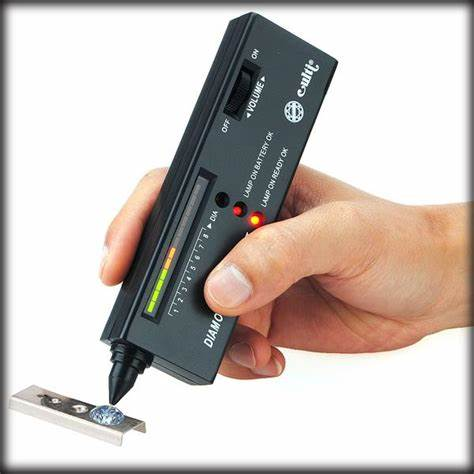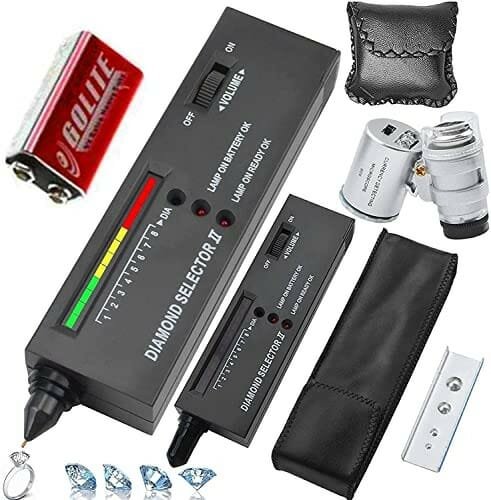
How Does The Diamond Tester Work?
There are numerous ways to tell if a diamond is genuine or fake, but it can be challenging to make this determination. However, using a diamond tester is one of the quickest and most accurate ways to determine whether a diamond is real or fake. Therefore, you will discover more about the diamond tester and its operation in this article. Therefore, let’s get started without wasting any time.
What are Diamond Testers?
Diamond testers are portable, compact tools used to determine the legitimacy of diamonds. The device will show whether the diamond is genuine using its display or a sound signal. The small, needle-like tester tip is where the test stone must be placed. These instruments frequently have a small, rectangular body, a tiny needle on top, an integrated display, or both so you can hear the results.
Uses of Diamond Testers

Jewelers frequently use diamond testers to ensure that the stones are genuine. A jeweler must determine the type of stone a piece of jewelry contains before repairing it because various gemstones respond differently to heat, pressure, and stress.
The jeweler will ensure your diamond is natural before selling it or exchanging it for another. If you’re uncertain as to whether the stone is a diamond, you can always take it to a jewelry store and have it checked.
The Properties of the Diamond Tester

The simplest method of evaluating and determining the effectiveness of the diamond tester is to look at its characteristics and the tasks that each of these features or characteristics performs. The diamond tester is the best tool for determining whether or not genuine diamonds are present because it was expertly made to deliver an accurate result, is quick and precise, and is secure to use. The most crucial thing to know about it is that experts and beginners can use it. Running a business enables you to function without waiting for clients to come to you. The diamond tester has a clever design that provides the most precise results while still being easy to use.
1. Usage simplicity:
The tester’s small and large switches and portability make it possible to test diamonds quickly and effectively wherever you are. The sharp, needle-like end makes an audible sound when it comes into contact with metal, gems, or diamonds. The sound produced makes it simple to tell the difference between the materials being tested and whether the gem is a diamond.
2. Battery-powered:
It increases the tester’s convenience of usage while also enhancing mobility. The tester can operate with just one regular 8-volt battery. In addition to improving mobility, this makes the tester easier to use.
3. Exceptional Accuracy:
A professional diamond tester can accurately test for natural diamonds and distinguish them from imitations. The tester’s beeping will indicate whether you have a genuine diamond or a fake. The volume levels and bars also improve the accuracy of the tester’s readings and deductions.
Working Method of a Diamond Tester

The diamond tester primarily determines the rate at which heat is transmitted through the test gemstone. These portable diamond testers measure the test diamonds’ thermal and electrical conductivity. It is used to test for genuine and fake diamonds because it can tell the difference between the two by displaying different results for the analyzed stones.
Glass and other materials like cubic zirconia also transfer heat and electricity, but not in the identical way diamonds do. Due to their high level of accuracy, diamond testers allow you to test for diamonds quickly, which saves you a lot of time, effort, and money. Diamond testers or detectors may also use electrical currents or conductivity to estimate the number of currents and the rate of electricity flowing through the stone under investigation.
It is essential to distinguish between diamond testers with traditional and modern designs.
- You can tell whether a sample is genuine by looking at the heat transmission rates and other properties of the standard testers, which have metallic tips with heated ends that are then pressed against the more excellent surface of the test material.
- However, more recent or modern diamond tests can distinguish between natural and fake diamonds based on their physical traits. These testers include the delicate Ceres Diamond Tester, which has an incredibly high heat sensitivity and a small copper tip, making it a very precise and reliable diamond tester. The Rayner Diamond tester is excellent for commercial testing, the GIA Diamond pen uses a visibly greasy liquid that leaves apparent marks on non-absorbent diamond surfaces, and the fluorescence diamond testing uses UV to distinguish natural diamonds from imitations.
Therefore, by comparing the differences in heat transmission between various materials, you can determine whether the sample material is a genuine diamond or a fake one.
1. The Precision of the Diamond Tester
An electrical conductivity tester can quickly and accurately differentiate between a real and a fake diamond. It is advised not to rely on heat-based diamond testers because the results may be misleading if moissanite is mistaken for a diamond because they are very similar and share similar thermal characteristics. Using an electrically powered diamond tester is the only method you can rely on to check for diamonds and tell them apart from moissanite.
2. Diamond Testing Using Heat or Electricity
Thermal conductivity is a factor in determining whether or not a diamond is genuine in both electric and heat tests. It’s essential to remember that the electric diamond tester is ideal for distinguishing between diamonds and moissanite because it detects changes in the stones. In contrast, heat does not clearly distinguish between them.
3. Working of Diamond Tester On Gold
The diamond tester can test metals indirectly, even though its primary purpose is to distinguish diamonds from other stones and identify gemstones. The tester will, however, beep nonstop to let you know it is in contact with a metallic object if it comes into contact with gold.
4. Diamond Tester Working On Silver

Despite being able to detect metals, you cannot use the tester to check for specific metals, such as silver.
Conclusion
The diamond tester measures the conductivity level of the gemstone with great accuracy, and the results can be used to determine whether or not the item is genuine. On the other hand, diamond testers that could conduct heat and electricity were frequently employed in diamond testing. If you have access to them, we suggest testing your jewels with both of them and comparing the outcomes. Both approaches are reliable and frequently used to inspect diamonds before a sale or to confirm their legitimacy.
Also, remember that jewelry shops and diamond dealers more commonly use models based on calculating diamond electrical conductivity. You can therefore go there to have your diamond verified as real or fake. We are confident that you fully comprehend this topic, and we wish you success in your diamond testing projects! Please share your thoughts in the comments; we’re eager to read them.
Frequently Asked Questions
Is a diamond tester capable of evaluating rubies?
Yes! A diamond tester will also assess rubies and other genuine gemstones. You can also analyze some stones, like sapphires and emeralds, to find out if they are real or fake. A diamond tester will evaluate a gemstone’s authenticity using the same technology.
How should a genuine diamond be examined?
There are many different types of modern synthetic and simulant diamonds, and an old diamond tester won’t detect them because they share all the same chemical characteristics as authentic diamonds.
How to evaluate a diamond's quality using a magnifying glass?
With the aid of a magnifying glass, check the diamond to make sure it is accurate. Look inside the stone for flaws. The diamond is most likely a fake if you can’t find any.
What is inclusion?
The majority of natural diamonds have flaws, which are known as inclusions. Perfect diamonds are available, but due to their exceptionally high quality, they are either lab-created or extremely costly.
